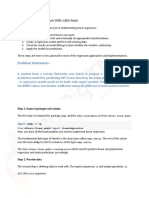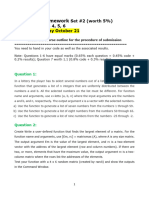Assignment 1
Uploaded by
Gs1995Assignment 1
Uploaded by
Gs1995Introduction to R- Application to Decision Sciences
Assignment 1
General Instructions:
You must create a R Script/file by the name “YourName_Assignment-1”. Send me the file
along with a pdf copy of the codes. The graphs must be saved as different files and sent to
me along with the assignment.
Please do not copy. You are free to discuss among yourselves but each one of you must write
your own code and send it to me.
You must interpret the results in Part II. The R script that you send should run on my laptop
as it is.
1. Create a vector named GMP. The size of the vector should be 10 and the elements in
the vector are multiples of 7 starting from 21.
2. Randomly select 5 numbers from the vector. Repeat the process 5 times and name
them GMP_vector_i, where i refers to the sample number. Create a matrix
GMP_matrix by combining these vectors. Name the rows as Student_i, where I refers
to the row number.
3. Transpose the matrix, find the inverse of the matrix and also the product of the
principal diagonal elements.
4. Create two matrices named Row Matrix and Column Matrix. The elements of these
matrices are the GMP_matrix elements sorted row-wise and column-wise respectively.
5. Compute the column-wise and row-wise mean and variances for the GMP_matrix.
6. Plot the means obtained above. (Use Scatter-Plot and Bar Charts with appropriate
names). Also create two pie-charts (one each for Column Mean and Row-mean).
7. Transform the elements in the GMP_matrix using the following transformation:
𝑓 (𝑥) = λ * e-λ / x!
You must use the for loop.
8. Plot x and f(x).
Part-II
Consider the following system of linear equations:
Solve the system of equations using Matrices.
Consider the dataset Women. Name the columns as Height and Weight respectively.
Check whether the mean height =65 and mean weight =115. Also check if the
variance of height and weight are same.
Perform a linear regression with Weight as the dependent variable. Name the
regression object as Regress. Carry out the regression diagnostics.
Plot the variables and also the best fit line.
Create prediction intervals (90, 95 and 99%) and plot them along with the best fit line.
Create a new variable HSquare= Height2. Repeat the regression now using two
independent variables Height and HSquare.
Use forward and backward regression to arrive at the best model.
You might also like
- A New Scheduler in xv6: Sumith (140050081) Shubham Goel (140050086)No ratings yetA New Scheduler in xv6: Sumith (140050081) Shubham Goel (140050086)4 pages
- Regression Week 2: Multiple Linear Regression Assignment 1: If You Are Using Graphlab CreateNo ratings yetRegression Week 2: Multiple Linear Regression Assignment 1: If You Are Using Graphlab Create1 page
- Java Lab 2025_B.tech-4th Semester_Upto ArrayNo ratings yetJava Lab 2025_B.tech-4th Semester_Upto Array5 pages
- BCSE I A2 Group CPNM Assignment 3: (Optional)No ratings yetBCSE I A2 Group CPNM Assignment 3: (Optional)2 pages
- Jadavpur University Session 2021-2022, Odd Semester Computer Programming and Numerical MethodsNo ratings yetJadavpur University Session 2021-2022, Odd Semester Computer Programming and Numerical Methods2 pages
- MKP (PCIT4303) JAVA 5 IT 68 Java AssignmentsNo ratings yetMKP (PCIT4303) JAVA 5 IT 68 Java Assignments16 pages
- Intro to Programming with Python - Assignment 5No ratings yetIntro to Programming with Python - Assignment 55 pages
- List of Practicals - CSHP101 S/W Lab Based On CSHT 101 Programming Fundamentals - C++No ratings yetList of Practicals - CSHP101 S/W Lab Based On CSHT 101 Programming Fundamentals - C++4 pages
- NUMB3RS Activity: Is This Seat Taken? Episode: "Soft Target"No ratings yetNUMB3RS Activity: Is This Seat Taken? Episode: "Soft Target"4 pages
- Wing Pendidikan 200/elektronika Skadron Pendidikan 203No ratings yetWing Pendidikan 200/elektronika Skadron Pendidikan 20313 pages
- FLIR T420, FLIR T420 Thermal Imaging Camera FLIR T 420No ratings yetFLIR T420, FLIR T420 Thermal Imaging Camera FLIR T 4202 pages
- Abc de Coordinacion de Corriente 1-10 PDFNo ratings yetAbc de Coordinacion de Corriente 1-10 PDF10 pages
- Controlling Stepper Motor Using 8051 MicrocontrollerNo ratings yetControlling Stepper Motor Using 8051 Microcontroller14 pages
- Cahigam Es Grade 5 Q1 Data-Bank-In-Math-5No ratings yetCahigam Es Grade 5 Q1 Data-Bank-In-Math-54 pages
- Introduction To Java Programming Comprehensive Version 9th Edition Liang Test Bank100% (33)Introduction To Java Programming Comprehensive Version 9th Edition Liang Test Bank7 pages
- Three-And Four-Point Method: Resistance MeasurementsNo ratings yetThree-And Four-Point Method: Resistance Measurements8 pages
- Crossovers The Basics: What Is A Crossover?No ratings yetCrossovers The Basics: What Is A Crossover?5 pages
- Java Swing Components Are Not Thread-Safe in JavaNo ratings yetJava Swing Components Are Not Thread-Safe in Java2 pages

























































































